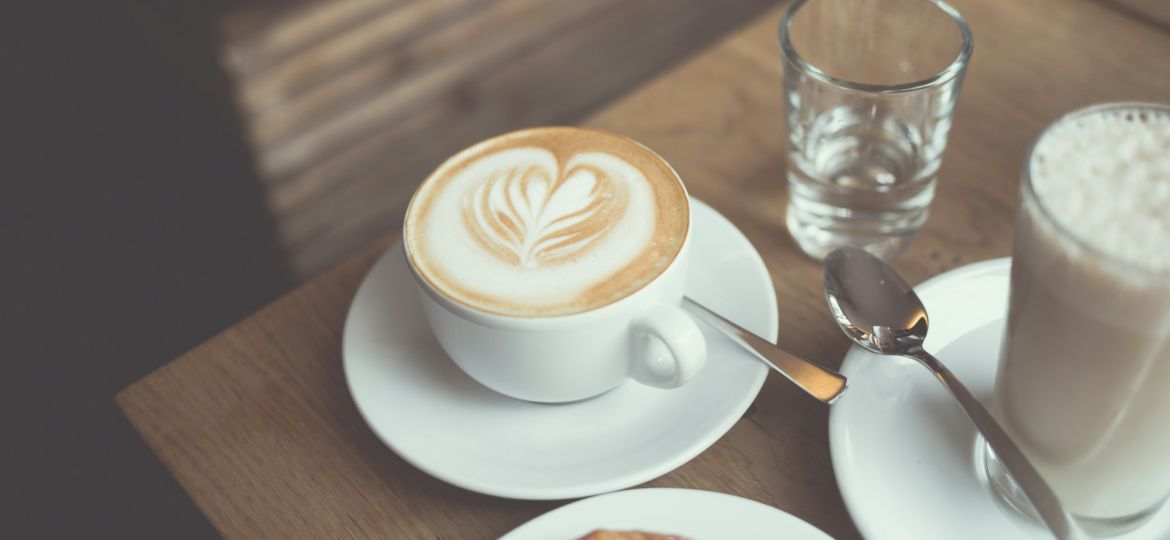
At the heart of these drinks is espresso – a concentrated coffee brewed by forcing hot water under pressure through finely-ground coffee beans. This brewing method extracts intense flavors and a rich aroma, forming the base for a variety of popular drinks.
Now, let’s talk about milk. It’s not just a filler; it’s a crucial ingredient that complements the boldness of espresso. The way milk is prepared and added to espresso can transform the drink entirely. Steamed milk, which is milk heated and frothed using a steam wand, creates a creamy, velvety texture.
But it’s not just about mixing espresso with steamed milk. The proportions and technique matter a lot. For instance, a latte involves more steamed milk and less foam, making it creamier and milder in taste. On the other hand, a cappuccino balances equal parts of espresso, steamed milk, and milk foam, offering a stronger espresso flavor with a lighter, airy texture.
Latte
Composition and Variations
A latte is like a warm hug in a cup, perfect for those who love their coffee creamy and smooth.
At its core, a latte consists of espresso and steamed milk, usually in a ratio that favors more milk.
The standard recipe involves one-third espresso and two-thirds steamed milk, topped with a light layer of foam.
Lattes are versatile, making them a favorite for both coffee newbies and aficionados.
Iced Lattes
When the weather heats up, iced lattes are the way to go. These chilled beauties are a simple yet delightful blend of espresso, cold milk, and ice.
The key here is the balance – too much ice and it’s watered down, too little and it’s not refreshing enough.
Unlike their hot counterpart, iced lattes usually skip the foam, focusing on the cool, creamy texture of milk and the robust espresso shot.
They’re incredibly refreshing and a perfect pick-me-up on a hot day.
Plus, you can still add those flavored syrups for a sweet, personalized touch.
Cappuccino
Traditional vs. Modern Cappuccinos
Cappuccinos have a rich history and have evolved over time.
Traditionally, a cappuccino is an equal trio of espresso, steamed milk, and frothy milk foam.
This classic Italian beverage is known for its strong espresso flavor and luxurious texture.
However, modern cappuccinos have taken some creative liberties.
Some places serve them larger, with more milk than the traditional recipe calls for, making them milder in taste.
Others focus on the art of foam, creating intricate designs on top.
Despite these variations, the heart of a cappuccino remains its balanced composition and rich, bold flavor.
Flavor Profile and Serving Sizes
Cappuccinos are all about the perfect harmony of flavors and textures.
The robustness of espresso, the creaminess of steamed milk, and the lightness of foam come together to create a full-bodied experience.
In terms of flavor, cappuccinos offer a stronger coffee taste compared to lattes, thanks to the higher espresso-to-milk ratio.
As for serving sizes, traditional cappuccinos are served in smaller cups, typically around 5-6 ounces.
This size is ideal for maintaining the perfect balance of espresso, milk, and foam.
However, in many coffee shops, you’ll find larger sizes available, catering to those who prefer a milder flavor or simply want more of that delicious coffee goodness.
Flat White
Origin and Characteristics
The flat white, a coffee drink that’s as smooth as it sounds, hails from Australia and New Zealand.
It’s like the cooler, edgier cousin of the latte and cappuccino.
A flat white is typically made with a double shot of espresso and a smaller amount of steamed milk.
What sets it apart is the milk’s texture – it’s velvety and not too frothy, creating a rich and creamy consistency.
The drink is served in a smaller cup, which means you get to enjoy a stronger coffee flavor compared to a latte.
It’s perfect for those who love their coffee with a bit more kick but still appreciate the smoothness of milk.
Comparison with Cappuccino and Latte
When you put a flat white next to a latte and a cappuccino, you’ll notice some key differences.
The flat white has a higher coffee-to-milk ratio than a latte, offering a stronger espresso flavor.
Unlike a cappuccino, it doesn’t have that thick layer of frothy foam on top.
This makes the flat white smoother and more integrated in terms of flavor and texture.
It’s the middle ground for those who find lattes too milky and cappuccinos too foamy.
Cortado / Gibraltar
Description and Serving Style
The Cortado, also known as Gibraltar in some parts, is a no-nonsense kind of coffee.
It’s all about striking a balance between espresso and milk.
This drink typically consists of equal parts espresso and steamed milk.
The milk in a cortado is steamed but not frothy, aiming to reduce the acidity of the espresso.
Served in a small glass, usually around 4-5 ounces, it’s perfect for those who want to savor their coffee without the heft of a larger milk drink.
The cortado is straightforward, compact, and packs a punch.
Flavor Intensity and Popularity
Cortados have gained a loyal following for their bold yet balanced flavor.
They offer a more intense coffee experience than a latte or flat white, but are less harsh than a straight shot of espresso.
This intensity comes from the equal ratio of espresso to milk, which allows the coffee’s natural flavors to shine through without overpowering the palate.
In coffee circles, the cortado is admired for its simplicity and elegance.
It’s a popular choice among coffee enthusiasts who appreciate the nuanced flavors of espresso.
Macchiato
Traditional vs. Modern Interpretations
The macchiato has undergone quite the transformation from its traditional roots to modern interpretations.
Originally, a macchiato was simply an espresso with a small dollop of milk foam on top – just enough to ‘stain’ the espresso, which is actually what ‘macchiato’ means in Italian.
Fast forward to today, and you’ll find the term ‘macchiato’ used for a variety of drinks, often loaded with syrups and much larger in size.
This modern take is more about sweetness and flavor infusions, moving away from the minimalist approach of the traditional version.
While both styles have their place, it’s important to know which one you’re getting – a simple, classic espresso macchiato or a more elaborate, dessert-like drink.
Flavor Profile and Serving Suggestions
The traditional macchiato offers a strong, robust espresso flavor with just a hint of creaminess from the foam.
It’s perfect for those who enjoy the intensity of espresso but want a touch of smoothness without diluting the coffee’s strength.
Served in a small cup, it’s a quick, intense coffee experience.
On the other hand, the modern macchiato is all about customization.
You can play with flavors, from caramel to hazelnut, and enjoy a sweeter, more indulgent beverage.
These are usually served in larger cups and are more akin to a dessert than a traditional coffee.
Whether you prefer the classic or the contemporary, the macchiato can be tailored to suit your taste buds.
What’s A Breve?
Definition and Variations
Ever heard of a Breve? It’s like the richer, creamier cousin of the classic latte.
At its core, a Breve is an espresso-based drink made with half-and-half instead of regular milk.
This switch-up results in a thicker, more luxurious texture and a richer flavor profile.
It’s a fantastic choice for those who find regular lattes a bit too light and crave something more indulgent.
But the fun doesn’t stop there – you can apply the ‘breve’ style to almost any espresso and milk drink.
Imagine a cappuccino with that extra creamy kick, or a macchiato that’s just a bit more decadent.
Breves are all about that extra richness and are perfect for when you want to treat yourself to something special.
Understanding Dry and Wet Drinks
Meaning and Customization Options
In the world of espresso drinks, ‘dry’ and ‘wet’ aren’t just about how much you spill on your shirt.
These terms actually refer to the amount of foam in your coffee.
A ‘dry’ drink means more foam and less liquid milk.
Think of a cappuccino with a thick layer of frothy goodness – that’s a classic example of a dry coffee.
It’s ideal for those who love the texture and taste of foam but don’t want their drink too milky.
On the flip side, a ‘wet’ drink has more steamed milk and less foam.
This makes for a creamier, smoother beverage, like a latte with just a thin layer of foam on top.
Wet drinks are great for those who prefer a milder coffee flavor and a silkier texture.
The beauty of these terms is that they let you customize your drink to your exact liking.
Whether you’re a foam fanatic or a milk maven, you can tweak your coffee to be as wet or as dry as you desire.
FAQs
What’s the difference between a latte and a cappuccino?
A latte has more steamed milk and less foam, making it creamier. A cappuccino balances equal parts of espresso, steamed milk, and foam, offering a stronger coffee flavor.
Can I make espresso drinks without an espresso machine?
While an espresso machine is ideal, you can use alternatives like a Moka pot or Aeropress for a similar strong coffee base.
What does ‘macchiato’ mean?
Macchiato means ‘stained’ in Italian, referring to the espresso ‘stained’ with a dollop of milk foam.
Is a flat white stronger than a latte?
Yes, a flat white typically has a higher coffee-to-milk ratio, making it stronger in flavor than a latte.
Summarizing Espresso and Milk Drinks
Espresso and milk drinks are a delightful world of flavors and textures, each with its unique character.
From the creamy latte to the balanced cappuccino, the robust macchiato, and the smooth flat white, there’s a style for every coffee lover.
Understanding the differences and customizations available, like dry and wet options or the indulgent breve, allows you to find your perfect coffee match.
So next time you order, you’ll not only get a delicious drink but also a little piece of coffee culture.









